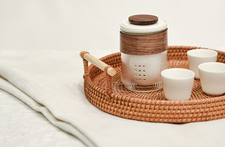Customize your system tray with YAD
Bespoke System Tray

© Photo by Suhyeon Choi on Unsplash
YAD lets you customize your system tray with one-line Bash tray scripts.
My goal was to find a simple way to group together my favorite apps and web pages into a system tray item. There are a number of different approaches to this, but for my requirements I found that the YAD (Yet Another Dialog) tool [1] gave me everything that I needed, and I could do it all with just one line of Bash script.
In this article, I will introduce Bash tray scripts with three examples. The first example will show how to create tray scripts that put Linux diagnostic data into both custom dialogs and terminal windows. In the second example, I will add pop-up browser windows to a right-click submenu. The final example will look at how to toggle the tray icon, command, and tooltip with simulated weather conditions.
Getting Started
There are a number of different tools for creating system tray applications, such as AllTray and KDocker. For my projects, I prefer YAD because it lets you create custom dialogs and it supports dynamic changes to the tray features. YAD is a command-line dialog tool very similar to Zenity [2], but with some added features such as system tray support and a more complete dialog functionality.
[...]
Buy this article as PDF
(incl. VAT)
